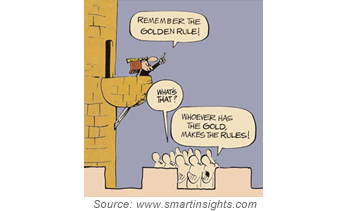3.4 Being Courteous
Common courtesy is a key to safety. Always drive with a good attitude towards other drivers by never insisting upon getting the right-of-way. Being courteous can help avoid accidents and keep traffic moving in an orderly fashion. Courtesy makes order out of chaos and is contagious.
Treat Other Drivers the Way You Want To Be Treated
The Golden Rule of treating others as you would have them treat you, also applies to driving. Give space in your lane to a driver that is trying to merge, and perhaps down the road another driver will do that same for you. The opposite of this rule applies as well. Do not honk with anger, scream, cut off others, tailgate, or flash your headlights, because you would not want another driver to do this to you.

Drivers Share The Roadway
Safely sharing the roadway with other drivers and pedestrians is essential for avoiding accidents. Always be aware of your surroundings and watch out for other drivers. If you are blocking traffic by going too slow, be courteous by moving out of their way to let them pass.
Having a good social attitude greatly increases your ability to drive with consideration of others. From a psychological point of view, the top-notch driver not only has skill, but also balance and self-control. This quality is called the “driving conscience” and is characterized by:
- Courtesy
- Good sportsmanship
- Acceptance of responsibility
- Consideration for others, including car occupants
- Good judgment
- Controlled attention
- Alertness
- Foresight
- A good attitude toward other roadway users, toward the laws and law enforcement
Not only should you be courteous to other drivers, but you should show yourself the same respect and consideration. Give yourself extra time, so that you do not feel stressed while driving and arrive at your destination on time. Ample time can mean the difference between a safe, relaxed trip and one filled with pressured driving.

You should also take care to realize when you’re in no condition to drive. This doesn’t simply mean impairment from alcohol or other drugs, but from ill health, emotional distress, or physical limitations. Think about whether you can be a safe driver before you start your engine.
Always check your driving techniques to ensure that you are being courteous. Ask yourself the following questions:
- Do you do the very things that make you angry with other drivers?
- Do you straddle lanes, drive slower than the flow of traffic, and forget to signal or merge into traffic too abruptly? If so, your driving techniques need improvement.
- Do you observe the total traffic picture?
- Do you keep your eyes moving, especially when changing lanes and at intersections?
- Do you use your mirrors and check over your shoulder?
- Do you check your car periodically for proper maintenance, making sure your brakes, lights and turn signals are in good working order?

